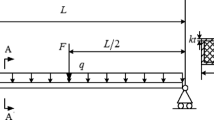Abstract
Numerical simulations, irrespective of the discipline or application, are often plagued by arbitrary numerical and modeling choices. Arbitrary choices can originate from kinematic assumptions, for example the use of 1D beam, 2D shell, or 3D continuum elements, mesh discretization choices, boundary condition models, and the representation of contact and friction in the simulation. This works takes a step toward understanding the effect of arbitrary choices and model-form assumptions on the accuracy of numerical predictions. The application is the simulation of the first four resonant frequencies of a one-story aluminum portal frame structure under free-free boundary conditions. The main challenge of the portal frame structure resides in modeling joint connections, for which different modeling assumptions are available. To study this model-form uncertainty, and compare it to other types of uncertainty, two finite element models are developed using solid elements, and with differing representations of the beam-to-column and column-to-base plate connections: (1) contact stiffness coefficients or (2) tied nodes. Test-analysis correlation is performed by comparing the range of numerical predictions obtained from parametric studies of the joint modeling strategies to the range of experimentally obtained natural frequencies. The approach proposed is, first, to characterize the experimental variability of the joints by varying the bolt torque, method of bolt tightening, and the sequence in which the bolts are tightened. The second step is to convert what is learned from these experimental studies to models that bound the range of observed bolt behavior. We show that this approach, that combines small-scale experiments, sensitivity analysis studies, and bounding-case models, successfully produces bounds of numerical predictions that match those measured experimentally on the frame structure. (Approved for unlimited, public release, LA-UR-13-27561.)
Access this chapter
Tax calculation will be finalised at checkout
Purchases are for personal use only
Similar content being viewed by others
References
Alfaro JR, Arana I, Arazuri S, Jarén C (2010) Assessing the safety provided by SAE J2194 standard and code 4 standard code for testing ROPS, using finite element analysis. Biosyst Eng 105(2):189–197
ASCE (1998) Minimum design loads for buildings and other structures. American Society of Civil Engineers, Reston, VA
SAE J2940 (2011) Use of model verification and validation in product reliability and confidence assessments. Ground Vehicle Reliability Committee, Oct 2011
Det Norske Veritas (2010) Design and manufacture of wind turbine blades, offshore and onshore wind turbines, Oct 2010
Freebury G, Musial W (2000) Determining equivalent damage loading for full-scale wind turbine blade fatigue tests. In: 19th ASME wind energy symposium, Reno, Nevada
Freitas CJ (2002) The issue of numerical uncertainty. Appl Math Model 26(2):237–248
Mollineaux MG, Van Buren KL, Hemez FM, Atamturktur S (2013) Simulating the dynamics of wind turbine blades: Part I, Model development and verification. Wind Energy 16(5):694–710
Veldkamp D (2008) A probabilistic evaluation of wind turbine fatigue design rules. Wind Energy 11(6):655–672
Wilson GE, Boyack BE (1998) The role of the PIRT process in experiments, code development and code applications associated with reactor safety analysis. Nucl Eng Des 186(1–2):23–37
Chatfield C (1995) Model uncertainty, data mining, and statistical inference. J R Stat Soc A Stat Soc 158(3):419–466
Ewins DJ, Inman DJ (eds) (2000) Structural dynamics 2000: current status and future directions. Baldock Research Studies Press, Baldock
Segalman DJ, Gregory DL, Starr MJ, Resor BR, Jew MD, Lauffer JP, Ames NM (2009) Handbook on dynamics of jointed structures. Technical report SAND2009-4164, Sandia National Laboratories, Albuquerque, NM, July 2009
Hemez FM, Cornwell PJ, Avitabile P (2008) Validation of finite element predictions of the dynamic response of a frame structure. In: 26th SEM international modal analysis conference, Orlando, FL, 4–7 Feb 2008
Gonzales LM, Hall TM, Van Buren KL, Anton SR, Hemez FM (2013) Quantification of prediction bounds caused by model form uncertainty. Technical report LA-UR-13-27561, Los Alamos National Laboratory, Los Alamos, NM, Sept 2013
Acknowledgements
This work is performed under the auspices of the Los Alamos National Laboratory (LANL) as part of the Los Alamos Dynamics Summer School (LADSS). The authors are grateful to Dr. Charles Farrar, The Engineering Institute, for organizing the LADSS. The authors also wish to express their gratitude to Dr. Peter Avitabile, University of Massachusetts Lowell, for guidance in the experimental testing. The companies Simulia and Vibrant Technology, Inc., graciously contributed Abaqus and ME’Scope software licenses to the LADSS, without which this work would not have been possible. LANL is operated by the Los Alamos National Security, L.L.C., for the National Nuclear Security Administration of the U.S. Department of Energy under contract DE-AC52-06NA25396.
Author information
Authors and Affiliations
Corresponding author
Editor information
Editors and Affiliations
Rights and permissions
Copyright information
© 2014 The Society for Experimental Mechanics, Inc.
About this paper
Cite this paper
Gonzales, L.M., Hall, T.M., Van Buren, K.L., Anton, S.R., Hemez, F.M. (2014). Quantification of Prediction Bounds Caused by Model Form Uncertainty. In: Atamturktur, H., Moaveni, B., Papadimitriou, C., Schoenherr, T. (eds) Model Validation and Uncertainty Quantification, Volume 3. Conference Proceedings of the Society for Experimental Mechanics Series. Springer, Cham. https://doi.org/10.1007/978-3-319-04552-8_6
Download citation
DOI: https://doi.org/10.1007/978-3-319-04552-8_6
Published:
Publisher Name: Springer, Cham
Print ISBN: 978-3-319-04551-1
Online ISBN: 978-3-319-04552-8
eBook Packages: EngineeringEngineering (R0)




